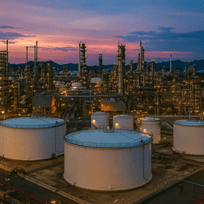The Organization of the Petroleum Exporting Countries (OPEC) released its September 2025 Monthly Oil Market Report (MOMR), offering a detailed overview of crude oil price movements, global supply and demand forecasts, commercial stock changes, and tanker market trends. This comprehensive assessment provides valuable insights into the evolving dynamics of the global oil market, which continues to face challenges from fluctuating prices, regional disparities in demand, and shifting supply balances.
Crude Oil Price Movements
The OPEC Reference Basket (ORB), a key benchmark for crude oil prices, recorded notable declines in August 2025. In nominal terms, the ORB averaged $69.73 per barrel, while in real terms (adjusted for inflation), it stood at $66.12 per barrel. This reflects a 1.7% month-on-month (m-o-m) decline and a 13.9% year-on-year (y-o-y) fall, underscoring the persistent weakness in crude marketsb9dab761-4203-4eb1-902c-335d4c0….
The downward pressure on prices has been influenced by several factors:
- Global macroeconomic headwinds, including slower-than-expected recovery in some OECD regions.
- Currency fluctuations, particularly the strengthening U.S. dollar, which has historically weighed on commodity prices.
- Refined product margins softening in certain markets, reducing refinery incentives for crude runs.
While short-term demand remains resilient in non-OECD economies, these price adjustments highlight the fragile balance between supply and demand.
World Oil Demand Forecast
OPEC maintained its outlook for global oil demand growth in 2025 at 1.3 million barrels per day (mb/d). This would bring total demand to 105.14 mb/d, reflecting steady consumption patterns despite regional differences .
- OECD Countries: Demand is projected to rise by just 0.1 mb/d y-o-y, primarily supported by the OECD Americas, while Europe contributes modestly. In contrast, OECD Asia-Pacific is expected to post a slight decline, reflecting structural energy efficiency gains and demographic shifts .
- Non-OECD Countries: These economies remain the main drivers of oil demand growth, accounting for 1.2 mb/d of the 2025 increase. Strong momentum is seen in China, India, and Other Asia, where industrial activity and transportation needs remain robust .
Looking ahead to 2026, OPEC forecasts global demand to expand by 1.4 mb/d, with OECD demand rising by 0.2 mb/d and non-OECD economies sustaining 1.2 mb/d of growth. Transport fuels (gasoline, diesel, jet fuel) and petrochemical feedstocks (LPG, naphtha) will remain the key demand engines .
World Oil Supply
On the supply side, OPEC reported that global liquids production continues to adjust in response to market signals:
- Non-OPEC Production: Liquids output from non-Declaration of Cooperation (non-DoC) countries is forecast to expand by 0.8 mb/d in 2025, reaching an average of 54.0 mb/d. Growth is primarily driven by the United States, Brazil, Canada, and Argentina, while Angola is expected to see declinesb9dab761-4203-4eb1-902c-335d4c0….
- OPEC Liquids (NGLs and Non-Conventional): OPEC natural gas liquids (NGLs) and other non-conventional output are set to rise by 130 thousand barrels per day (tb/d) in 2025, averaging 5.9 mb/d. Further growth of 150 tb/d is projected in 2026b9dab761-4203-4eb1-902c-335d4c0….
- OPEC Crude: According to secondary sources, DoC crude oil production in August 2025 rose by 509 tb/d, averaging 42.40 mb/db9dab761-4203-4eb1-902c-335d4c0….
The balance of supply and demand suggests that while incremental increases from non-OPEC countries will meet some demand, OPEC remains a pivotal swing producer in stabilizing global markets.
Commercial Stock Movements
Inventories play a crucial role in assessing market tightness. Preliminary July 2025 data show that OECD commercial oil stocks stood at 2,761 mb, reflecting a build of 2.4 mb from June . However, this level remains:
- 66.5 mb lower than July 2024,
- 128.5 mb below the latest five-year average, and
- 208.6 mb beneath the 2015–2019 average.
Crude vs. Products:
- Crude stocks rose by 3.6 mb m-o-m, ending July at 1,317 mb.
- Product stocks, however, fell by 1.3 mb m-o-m, totaling 1,444 mb .
Regional Analysis:
- OECD Americas: Saw the largest build, adding 15.2 mb to reach 1,513 mb, although still 49.1 mb below the five-year average.
- OECD Europe: Declined by 7.8 mb, with crude and product stocks both drawing.
- OECD Asia-Pacific: Fell by 5.1 mb, though levels remained slightly above 2024 .
Forward cover for OECD stocks stood at 59.6 days, slightly up from June but still below historical averages. These figures suggest that while short-term supply remains adequate, inventories are well below comfort levels, leaving markets vulnerable to disruptions.
Tanker Market Trends
The tanker market showed a mixed but generally stronger performance in August 2025:
- VLCCs (Very Large Crude Carriers): Spot freight rates rose 11% m-o-m, with Middle East-to-East routes up 19%, averaging WS57 .
- Suezmax: Rates surged 34% m-o-m and 38% y-o-y, with the West Africa-to-US Gulf Coast route jumping 38% to WS101 .
- Aframax: Rates increased 9% m-o-m, with notable gains on the Caribbean-to-US East Coast route (+23%). However, the Indonesia-to-East route saw a 7% decline .
- Clean Tankers: Rates were slightly weaker overall, except for Middle East-to-East voyages, which rose 5% m-o-m, reflecting stronger Asian demand .
These freight dynamics highlight the role of regional flows, with strong transatlantic and Asia-bound activity offsetting weakness elsewhere.
Market Outlook and Implications
The September 2025 MOMR underscores several key themes for the months ahead:
- Fragile Price Stability: With ORB prices below $70/b, oil remains under pressure. Any geopolitical shock or unexpected supply disruption could sharply swing prices.
- Non-OECD Growth as the Engine: Demand growth is overwhelmingly concentrated in Asia, with China and India expected to account for nearly one-third of global incremental demand.
- Inventory Deficit Risks: OECD stocks remain significantly below five-year averages, creating vulnerability if supply growth underperforms.
- Shipping Costs Rising: Higher tanker freight rates, especially on key routes, will impact delivered crude costs for refiners, influencing margins and product pricing.
- OPEC’s Central Role: Despite rising output from non-OPEC producers, the group’s supply management policies will remain the primary stabilizing force in the market.
Conclusion
OPEC’s September 2025 MOMR paints a picture of cautious stability in the global oil market. Prices remain soft, but demand continues to grow steadily, driven by emerging economies. Supply expansions from North and South America offer balance, but the persistent inventory deficit in OECD regions underscores the fragility of the system.
For investors and market participants, the report signals both risks and opportunities: tanker markets are tightening, refinery margins are uneven, and OPEC’s production strategy remains pivotal. The interplay of these dynamics will shape energy markets as the world heads into the final quarter of 2025.
References
- OPEC.org, Monthly Oil Market Report
Disclaimer
The content on MarketsFN.com is provided for educational and informational purposes only. It does not constitute financial advice, investment recommendations, or trading guidance. All investments involve risks, and past performance does not guarantee future results. You are solely responsible for your investment decisions and should conduct independent research and consult a qualified financial advisor before acting. MarketsFN.com and its authors are not liable for any losses or damages arising from your use of this information.





